
The rating system of the Royal Navy and its predecessors was used by the Royal Navy between the beginning of the 17th century and the middle of the 19th century to categorise sailing warships, initially classing them according to their assigned complement of men, and later according to the number of their carriage-mounted guns. The rating system of the Royal Navy formally came to an end in the late 19th century by declaration of the Admiralty. The main cause behind this declaration focused on new types of gun, the introduction of steam propulsion and the use of iron and steel armour which made rating ships by the number of guns obsolete.
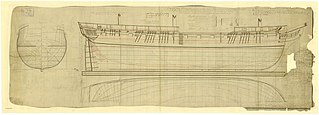
HMS Saldanha was a 36-gun fifth-rate Apollo-class frigate of the Royal Navy. She was commissioned in April 1810 and spent her entire career serving on the Irish Station, including capturing a fast-sailing French privateer on 11 October 1811. In the evening of 4 December that year Saldanha was serving off Lough Swilly when she was caught in a storm. Last seen sailing off Fanad Head, the ship was wrecked in a nearby bay with every person on board being killed and the only survivors being a parrot and a dog. The wreck was memorialised by Thomas Sheridan in his poem The Loss of the Saldanha.

HMS Amazon, was a 36-gun Amazon-class frigate, built at Rotherhithe in 1795 to a design by Sir William Rule. Carrying a main battery of 18-pounder long guns, she was the first of a class of four frigates. She had a short but eventful career during the French Revolutionary War, which she spent in the Channel and Western Approaches, part of a frigate squadron under Sir Edward Pellew. She was wrecked in Audierne Bay in 1797, following an action on 13 January with the French ship-of-the-line, Droits de l'Homme.
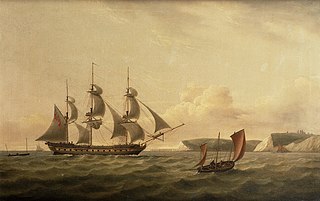
HMS Amazon was a 38-gun fifth-rate Amazon-class frigate of the Royal Navy. She served during the French Revolutionary and Napoleonic Wars under several notable naval commanders and played a key role in the Battle of Copenhagen under Edward Riou, who commanded the frigate squadron during the attack. After Riou was killed during the battle, command briefly devolved to John Quilliam. Quilliam made a significant impression on Horatio Nelson, who appointed Quilliam to serve on the flagship HMS Victory. Amazon passed to William Parker, who continued the association with Nelson with service in the Mediterranean and participation in the chase to the West Indies during the Trafalgar Campaign. Amazon went on to join Sir John Borlase Warren's squadron in the Atlantic and took part in the defeat of Charles-Alexandre Léon Durand Linois's forces at the action of 13 March 1806. During the battle, she hunted down and captured the 40-gun frigate Belle Poule.
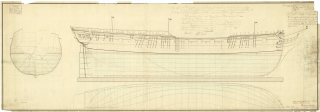
The Artois class were a series of nine frigates built to a 1793 design by Sir John Henslow, which served in the Royal Navy during the French Revolutionary and Napoleonic Wars.

HMS Aigle was a 36-gun, fifth-rate frigate of the Royal Navy. Ordered on 15 September 1799 and built at Bucklers Hard shipyard, she was launched 23 September 1801. More than fifty of her crew were involved in the Easton Massacre when she visited Portland in April 1803 to press recruits. Her captain and three other officers stood trial for murder but were acquitted. Much of Aigle's career as a frigate was spent trying to keep the English Channel free of enemy warships and merchant vessels. On 22 March 1808, she was first into the action against two large French frigates, compelling one to seek the shelter of the Île de Groix batteries and forcing the other onto the shore.

HMS Romulus was a 36-gun fifth rate frigate of the Flora class, built for the Royal Navy and launched in September 1785. At the outbreak of the French Revolutionary War, Romulus was despatched to the Mediterranean where she joined a fleet under Admiral Lord Hood, initially blockading, and later occupying, the port of Toulon. She played an active role during the withdrawal in December, providing covering fire while HMS Robust and HMS Leviathan removed allied troops from the waterfront.
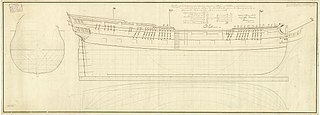
HMS Cato was a 50-gun Grampus-class fourth rate ship of the Royal Navy. One of a class of ships constructed for service in the American Revolutionary War, Cato was commissioned in 1782. She became the flagship of Sir Hyde Parker, and sailed with him to the East Indies Station later in the year. After stopping at Rio de Janeiro on 12 December, the ship sailed for the Cape of Good Hope and was never seen again. Theories on her disappearance include her being shipwrecked in locations such as the Malabar Coast and the Maldives, and the crew being murdered by natives. Sir John Knox Laughton argues that it is more likely that Cato caught fire and blew up at sea.
The Maidstone-class frigate was a 32-gun fifth-rate frigate class of two ships designed by Sir John Henslow and ordered on 4 February 1795. The class was a close copy of Henslow's earlier Alcmene class, but was constructed of pitch pine instead of oak. With concerns over whether the lighter building material would safely hold an armament of 18-pounder long guns, the class was instead armed with smaller 12-pounders. Both ships of the class served through the French Revolutionary Wars, but neither had a long career. Shannon was sold at Sheerness Dockyard in May 1802 and Maidstone was placed in ordinary at Chatham Dockyard in 1804 before being broken up in 1810.

HMS Caroline was a 36-gun fifth-rate Phoebe-class frigate of the Royal Navy. She was designed by Sir John Henslow and launched in 1795 at Rotherhithe by John Randall. Caroline was a lengthened copy of HMS Inconstant with improved speed but more instability. The frigate was commissioned in July 1795 under Captain William Luke to serve in the North Sea Fleet of Admiral Adam Duncan. Caroline spent less than a year in the North Sea before being transferred to the Lisbon Station. Here she was tasked to hunt down or interdict French shipping while protecting British merchant ships, with service taking her from off Lisbon to Cadiz and into the Mediterranean Sea. In 1799 the ship assisted in the tracking of the French fleet of Admiral Étienne Eustache Bruix, and in 1800 she participated in the blockade of Cadiz.

HMS Jason was a 36-gun fifth-rate Penelope-class frigate, launched in 1800. She served the entirety of her career in the English Channel, mostly in the frigate squadron of Commodore Charles Cunningham. Serving off the coast of France, especially around Le Havre and Cherbourg, she captured several French privateers and recaptured a British merchant ship in a cutting out expedition. Having only been in commission for around fifteen months, Jason was wrecked off the coast of St Malo on 21 July 1801. Her crew were saved and later exchanged, and in August her wreck was burned to prevent the French from rescuing it.

HMS Beaulieu was a 40-gun fifth-rate frigate of the Royal Navy. The ship was laid down in 1790 as a speculative build by the shipwright Henry Adams and purchased by the Royal Navy in June of the same year. Built to the dimensions of a merchant ship, Beaulieu was broader, with more storage capacity, than a standard frigate; though may not have had good sailing qualities. The frigate was commissioned in January 1793 by Lord Northesk and sent to serve on the Leeward Islands Station. She participated in the capture of Martinique in February 1794, and then was similarly present at the capture of the island of Saint Lucia in April. The frigate also took part in the initial stages of the invasion of Guadeloupe. Later in the year the ship's crew was beset by yellow fever and much depleted. Beaulieu was sent to serve on the North America Station to allow them to recuperate, returning to the Leeward Islands in 1795. In the following two years the ship found success in prizetaking and briefly took part in more operations at Saint Lucia. She returned to Britain at the end of 1796.

The Perseverance-class frigate was a 36-gun, later 42-gun, 18-pounder fifth-rate frigate class of twelve ships of the Royal Navy, constructed in two batches. Designed by Surveyor of the Navy Sir Edward Hunt the first iteration, consisting of four ships, was constructed as a rival to the similar Flora-class frigate. Strongly built ships, the Perseverance class provided favourable gunnery characteristics and was highly manoeuvrable, but bought these traits with a loss of speed. The name ship of the class, Perseverance, was ordered in 1779 and participated in the American Revolutionary War, but her three sister ships were constructed too late to take part. The class continued in service after the war, but soon became outdated.

HMS Resistance was a 36-gun fifth-rate Aigle-class frigate of the Royal Navy, one of a pair designed by Sir John Henslow. Resistance was commissioned in May 1801 by Captain Henry Digby, and after brief service in the English Channel the frigate left for Quebec in charge of a convoy. While on voyage Resistance captured the French privateer Elizabeth, which was the last ship captured during the French Revolutionary War. Having returned to England at the end of the year, the frigate resumed service in the English Channel, with Captain Philip Wodehouse replacing Digby. On 31 May 1803 Resistance was sailing to the Mediterranean Sea when she was wrecked off Cape St. Vincent; the crew survived.

The Narcissus-class frigate was a 32-gun, 18-pounder fifth-rate frigate class of five ships of the Royal Navy. Designed by Surveyor of the Navy Sir John Henslow, the class was created to make use of shipyards that could not construct larger frigates. They were similar in design to the preceding 32-gun frigate class, the Amphion class, but were slightly shorter. Two ships were initially constructed, with a later batch of three being ordered in response to an Admiralty request for the resumption of production of proven frigate designs. The final two ships of the class were cancelled when the shipyard they were being constructed at went bankrupt. Unlike her sister ships, the name ship of the class Narcissus was armed with experimental short 24 pounders rather than 18 pounders.
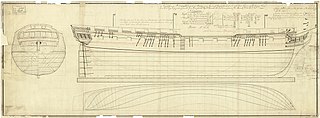
Aigle-class frigates were 36-gun sailing frigates of the fifth rate designed by Surveyor of the Navy, Sir John Henslow for the Royal Navy. Only two were built: HMS Aigle and HMS Resistance. Aigle was ordered first on 15 September 1798 but a 16-month delay during her construction meant that Resistance was completed and launched first on 29 April 1801.

HMS Manilla was a 36-gun fifth-rate Apollo-class frigate of the Royal Navy. Commissioned by Captain George Seymour in September 1809, Manilla's first service was in a squadron operating in the Tagus. She conveyed Lieutenant-General Sir John Sherbrooke to Halifax, Nova Scotia, in late 1811, returning to England with Lieutenant-General Gordon Drummond.

HMS Blanche was a 36-gun fifth-rate Apollo-class frigate of the Royal Navy. She was commissioned in 1800 by Captain Graham Hamond, under whom on 2 April 1801 Blanche fought as part of the frigate reserve at the Battle of Copenhagen. She spent the remainder of the French Revolutionary Wars serving in the English Channel. When the Napoleonic Wars began in 1803 Blanche was sent to serve in the West Indies under the command of Captain Zachary Mudge. There the frigate participated in the Blockade of Saint-Domingue and an unsuccessful invasion of Curacao, capturing upwards of twenty-four vessels.

HMS Trent was a fifth-rate sailing frigate of 36 guns, built for the Royal Navy and launched in February 1796. She carried a main battery of twenty-six 18-pounder (8.2-kilogram) long guns. She and her sister ship HMS Glenmore were constructed from pitch pine rather than oak.

The Amazon-class frigates of 1795 were a set of four 36-gun sailing frigates built for the Royal Navy and designed by William Rule. The first pair were constructed from oak and launched in July 1795. A second pair had already been ordered in January that year, to be made from pitch pine, one launched in February and the other in March of 1796. All four of the new class carried a main battery of twenty-six 18-pounder (8.2 kg) long guns supplemented with eight 32-pounder (15 kg) carronades and ten long guns, 9-pounder (4.1 kg) for the first pair, 12-pounder (5.4 kg) for the second batch, on the upperworks.
















